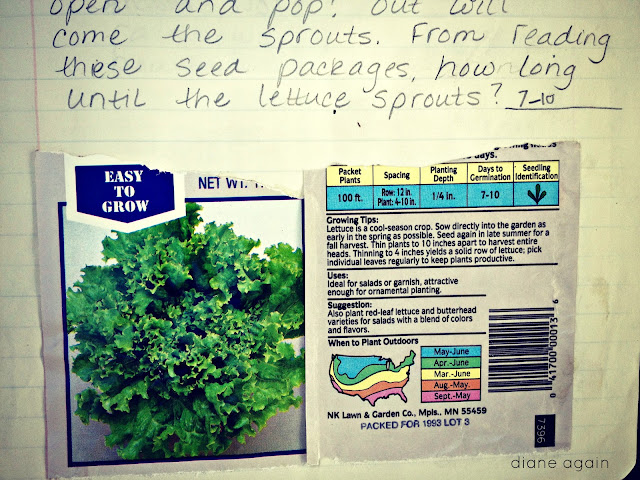Ever since my daughters were tiny wee toddlers, I had been making little surprises for them to find in the mornings. Alongside their cereal bowls, I might lay out a new game or a sheet of stickers or a little note or drawing that I had created the night before. Certainly, I didn't do this every day, and my creations changed over the months and years, but for a while, I made them cards that looked like this:
On one side was a visual; on the reverse, a little note from me relating the visual to our lives - I might tell a little story or encourage them to draw or color on the card. At the time I made these little tokens, I was just having fun...I had no idea how they would someday influence my daughters' educations.
Fast forward a few years to the official beginning of our homeschooling adventure. As soon as my first-born daughter decided to be done with kindergarten, I needed a clear plan of attack. Thanks to John Holt, I was bound and determined to give my daughters freedom to learn according to their own interests. Which meant there would be:
no workbooks
no textbooks
no 'reading books'
no assignments
no tests
no school hours
no assigned subjects
As I was raised in a traditional setting, this approach seemed permissive, bold and perhaps even foolhardy. Still, I was determined to give it my best shot.
At the same time, I thought a lot about my responsibility to introduce my daughters to the 3Rs. I didn't want to stifle them in meaningless busy work, but I didn't want them to be ignorant social misfits either. I was looking for some middle ground that would allow me to gently expose my daughters to the basics of reading, writing and arithmetic in a natural and casual way, tailored specifically to their own interests and preferences.
And that's when I remembered the cards I used to send them. Inspired by the personal and interactive style that had worked so well for them as babies, I adapted that practice to come up with a system that brought us years of fun and low-key learning.
Each girl picked out a spiral-bound notebook and decorated the cover to her heart's content. Then, in the evenings, I would write her a little note which usually included some kind of game or puzzle for her to solve. The next morning, we would read the note together, and then each daughter would work on the activity. Later, we would usually chat about how it went. Here are some examples:

My favorite games were the open-ended ones - I especially liked to play "Which two things are not like the other?" It was fascinating and interesting to hear the rationale behind each girl's choices and I gained great insights into understanding how each daughter's mind worked.
While some of the games had 'right' answers, I never corrected their work or directly pointed out their mistakes. Nothing squelches a good time like being told you are wrong.
I also did not force them to complete the activities. I took note of their disinterests as well as their interests, because understanding your learner is one of the main jobs of a teacher.
My overriding goal was not to teach facts but simply to stir up interest in my daughters' growing minds for reading, writing and math. By showing them the fun things one could do with numbers and letters, I hoped to prepare their nimble and fertile minds for all that was to come.
And you know what? These little books did just that. They are one of the great success stories of our earliest homeschooling days and sentimental treasures to boot.













No comments:
Post a Comment
Please comment...I'd love to hear from you!